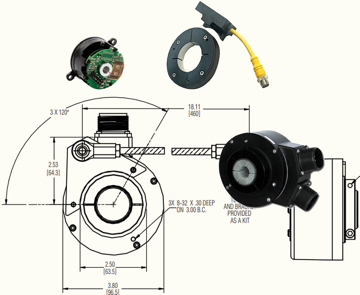How to Measure Distance with Draw Wire Encoders
When linear measurement is required, sometimes it is not feasible to utilize a linear encoder and a draw wire encoder is preferred. A linear encoder typically requires a fixed length scale and with longer measuring lengths this can become a challenge. As an example, mobile crane booms of telescopic type have a varying linear distance of considerable length. For this reason, draw wire encoders are a suitable choice.
Historically, multiple-turn potentiometers have been coupled with draw wires due to their simple nature and inherent absolute output (known as “string pots”). However, the contacting point, or wiper in the potentiometer is a wear point and is a life-limiting factor. It is also an analog device and, therefore, more susceptible to electrical noise. With encoders, the sensing element (whether optical or magnetic) is non-contact and therefore not a wear point consideration. Also coupled with the fact that many absolute encoders are networked devices (i.e. DeviceNet, ProfiBus, Ethernet, etc), they make wiring and communication with controls simpler. It is for these reasons that draw wire encoders are many times preferable over “string pots”.
How to calculate linear distance with draw wire encoders
A draw wire encoder consists of a rotary encoder mounted to the hub of a cable reel. As the reel is pulled, the rotary encoder generates pulses. Assuming constant diameter of the cable reel, first we need to determine the number of pulses per 1 inch of rotation of the reel (pulses per inch), which is the pulses per revolution divided by the diameter of the reel:

To calculate linear displacement, we take the number of pulses seen divided by the pulses per inch:

When to Use a Draw Wire Encoder
Multiple technologies exist for measuring distance, including linear encoders, follower wheels, and draw-wire encoders. Linear encoders can deliver very high accuracy, resolution, and repeatability. They are best suited to distances of around 10 feet or less, about the size of a standard package-delivery truck. Beyond that, the scales become expensive and difficult to mount properly. Rigid versions are hard to ship and flexible versions can be challenging to align reliably.
A follower wheel is the static analog of a draw-wire encoder. It consists of a precision encoder measuring wheel with an encoder mounted on the hub. The wheel sits atop the surface being measured. As a piece of glass, for example, passes under the wheel, the wheel turns on its hub. The encoder tracks the motion and its output can be converted to length. With the proper choice of encoder, follower wheel designs can monitor long travel distances.
It is important to note that a follower wheel is a mechanical assembly and thus subject to the same sets of issues as draw-wire encoders. The wheels can slip on the surface being measured. Applying preload helps prevent that slip but increases bearing wear. Finally, the follower wheel itself can wear. To address this problem, some wheels feature dual O-rings on the circumference that can be replaced when necessary, extending the lifetime of the wheel itself. And remember, the follower wheel, not the performance of the encoder, is the limiting error source.
For very long travel, particularly in harsh environments, a draw-wire encoder is probably the best bet. It's important to keep in mind that these are generalities, however. The only way to arrive at the best encoder for the application is to list the key requirements and conditions, and compare them to the benefits and drawbacks of the technologies above.
Customer Question: Can I use a draw-wire encoder for a 2-to-3-in travel range?
Answer: It is possible to make a draw-wire encoder with a two-to three-inch stroke. The question is why you are considering this technology. If you are working in a clean environment such as a lab, a linear encoder would provide a more compact, more accurate solution. For this application, a draw-wire encoder would be too bulky. If your application is out on the shop floor with dirt and metal shards, however, you cannot successfully use an optical linear encoder. In this case, a draw-wire encoder might be better.




